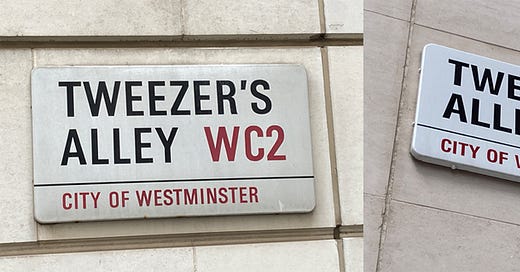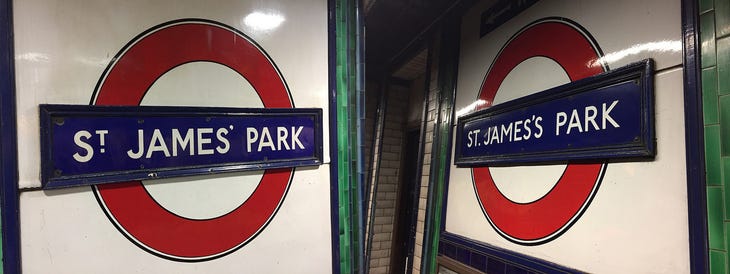Welcome to Londonist: Time Machine’s Friday newsletter for paying subscribers, with a wholesome extended teaser for everyone else.
A friend once said to me, “Matt, you’re such a pedantic.” To which I, of course, replied: “No, I’m a pedant”. But I’m not the only one. Most of us enjoy a bit of nitpicking or minor point-scoring, especially when it comes to language and grammar. In today’s newsletter, I pedant the heck out of London’s history.
First, though, some news about an upcoming site visit, and the usual History Radar…
Subscriber Site Visit
Ever had the urge to step inside a Victorian tomb? No? Not even one as handsome as this fellow?
UPDATE: This is now fully booked.
This is the final resting place of the 2nd Earl of Kilmorey and his ladyfriend Priscilla Anne Hoste. I’ve lined up a special visit that will take us inside the tomb. Regular readers might remember this mausoleum from my map of buildings that have moved around; and this tomb has moved twice. Its fascinating backstory of love and loss will be told by local guide Andrew George. He’ll not only unlock the mausoleum, allowing us to step inside, but will also give us a tour of historic Richmond and St Margarets (where the tomb lies). We will then, as is tradition on Time Machine visits, retire to a nearby pub for further historical discussion.
The tour will take place on the afternoon of Sunday 6 July 2025 (2pm to roughly 4pm), and is open to paying subscribers and their plus-ones. The cost is just £5 per person, payable on the day. To book up to two places, please email me on matt@londonist.com
History Radar
Upcoming events for fans of London history
🚴♀️ VELODROME: As part of Dulwich Festival, hear from a panel of guests about the history of Herne Hill Velodrome, at the heart of Dulwich since 1891. The panel will include, coaches, riders and those with long connections to this amazing venue. That’s on 12 May.
🍎 CHEAPSIDE: On 15 May, Guildhall Library offers a free talk by the ever-sparkling Pete Smith about the history of Cheapside, the street which today runs from St Paul's towards Bank, but which was once London's main shopping street, and arguably the most important thoroughfare in Britain.
🐑 HACKNEY HISTORY FEST: It's the second -- and final -- weekend of Hackney History Festival (17-18 May), with walks, talks and films celebrating the borough's history. Celebrate 40 years of Hackney City Farm, hear about the Dalston Peace Mural from two people who feature in it, and help get some Hackney women added to Wikipedia.
📜 CHEAM CHARTER FAIR: Rumour has it that the Cheam Charter Fair dates back to 1259 — though even the modern-day organisers can't verify that. Either way, head to the London-Surrey border on 17 May for a traditional fair of stalls, kicked off with a procession at 9am.
🏛️ SUNDAY FUN-DAY: On 18 May, take the kids along to Lauderdale House in Highgate for Sunday Fun-Day a day of free workshops aimed at 4-10 year olds, designed to teach them about the history of the building. The statue of Sir Sydney Waterlow in Waterlow Park provides inspiration for a model-making workshop.
Some Notes on London Pedantry
“I got off at Charing Cross train station and admired its cobblestone forecourt, walked down the Strand and on to Whitehall and gazed up at the face of Big Ben. I then looped back past the statue of Boadicea, and caught the Tube from Temple station.”
Two simple sentence; six pedantic errors (none are directional). Can you spot them? I’ll elaborate below.
London is a big, old, complicated city. It brings with it a big, old, complicated set of rules and customs. Some of these are physical. Thou shalt not stand on the left of the escalator. Thou shalt not feed the pigeons. Thou shalt not form an orderly queue at a bus stop, and most assuredly not while waiting to be served at a bar. Thou shalt not touch the walrus (if you know, you know).
Then there are the rules of name and place. These are the acceptable spellings, pronunciations, punctuations and definitions that can take a lifetime to fully understand. This is the Kingdom of the Pedant. A very treacherous realm it is.
The pedantry of London starts with the very definition of the city. What is London? The question has many answers. The pedant will insist on only one definition: it is the 32 London Boroughs plus the City of London.
This notion of London is only 60 years old. It dates from the formation of Greater London in 1965. Many cleave to older boundaries. One common indicator of London-ness is postcode. To qualify as a Londoner, says the theory, you need to have a London postcode. That is, something beginning with N, E, W or S, like SE1 for Southwark or WC1 for central Westminster. Such postcodes usually correspond to areas that fell within the old County of London, which was abolished in 1965 when London expanded.
Those souls living in Kingston have a KT postcode and so are not Londoners. Ditto Twickenham (TW), Bexleyheath (DA for Dartford), Romford (RM) and many others. This is enough for many Outer London residents to claim allegiance to Essex, Kent or Surrey rather than to the London Borough in which the actually live. This extra-municipal allegiance is sorely tested when the 60th birthday arrives: this entitles London residents exclusively to a free transport pass.
Using postcodes to define London has other drawbacks. For example, the village of Sewardstone near Chingford has always been in Essex and outside the borders of Greater London. And yet it has a thoroughly London E4 postcode.
The case of Sewardstone brings us to another matter: pronunciation. London is full of pitfalls in this respect, especially for non-Brits. Holborn, Cadogan Square, Leicester Square, Theydon Bois, Ruislip, Plaistow… I’ve heard Americans pronounce Pall Mall as Paul Mawl. The list goes on. As a rule of thumb, try to use as few vowels as possible. So Holborn is more-or-less correct as O’b’n. Leicester is approximately Lester. It doesn’t always work, though. Streatham is correctly enunciated as Saint Reatham. Or so I choose to believe.
Pronunciation can be hard to agree on, but some London places can’t event tie themselves to one spelling. The most high-profile culprit is the River Lea. This historic waterway through east London was once the boundary between the Danelaw and lands of the English; later between Essex and London; and now between Tower Hamlets and Newham (and, higher up, other boroughs). For such an important frontier it has a slippery name. Sometimes it’s the River Lea, sometimes Lee, and occasionally (historically) the Ley. In recent decades, the convention has been to call the natural flow the Lea, while adjacent navigation channels are typically spelled Lee. But not always. Elsewhere, we have the London Borough of Haringey, which is spelled differently from the town centre of Harringay. Both are derived from the personal name of an Anglo-Saxon chieftain, probably called something like Haering.
I don’t want to dwell too long on apostrophes. One could write a very long, very pedantic essay about where to put the apostrophe in London place names. King’s Cross or Kings Cross? Earl’s Court or Earls Court? Most such examples have preferred versions, usually thanks to standardisation on the Tube map (in the cases above, both have apostrophes, but Barons Court and Parsons Green, for example, do not). Ultimately, there is no correct answer other than convention. We could make arguments such as “Barons Court should really be Baron’s Court, because it once belonged to a baron and so needs a possessive apostrophe”. But, really, does it? Place names are simply labels. The presence of an apostrophe does not help with comprehension or way-finding, and only serves to clutter. (Plus, there never was a Baron of Barons Court.)
All that said, we should at least aspire to consistency. As anyone who pays attention to street signs will know, this is not always achieved. Just three examples:








